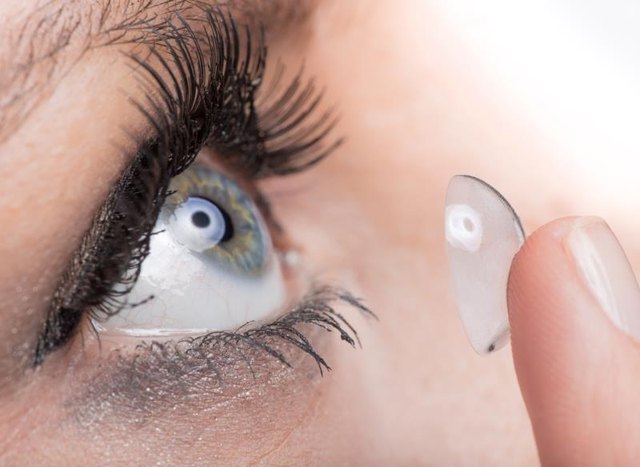
It eventually happens to almost all contact lens wearers: You fall asleep while still wearing your contacts. With approximately 10 percent of Americans wearing contact lenses regularly, according to the American Academy of Ophthalmology, concerns about sleeping with contact lenses are common. The potential for problems depends on the type of lenses you wear, how you care for them and your overall eye health.
Potential Corneal Problems
When you fall asleep wearing your contacts, your eyelid is closed over the contact that covers the cornea. Oxygen normally diffuses into corneal cells directly from the air. But with a closed eye, the cornea has less exposure to oxygen. In addition, nourishment and protection from germs come from the natural tears of the eye. A closed eye with a contact in place impedes fresh tear flow to the corneal cells. Lack of oxygen and tears may lead to short-term problems ranging from feeling like something is in the eye, blurred vision, red eye, burning, itching or a scratched cornea. More serious problems that may develop over time include abnormal blood vessel growth into the cornea, giant papillary conjunctivitis, or bumps on the underside of the lids causing mucus discharge and irritation. Corneal infection, which can lead to scarring and poor vision, is another possible outcome.
More Oxygen, Less Stress
In the quest for better oxygen permeability, the greatest breakthrough in contact lens material came with the introduction of soft silicone hydrogel lenses. Silicone has a high permeability for oxygen and allows for 6 to 7 times more oxygen passage than standard hydrogel lenses. For this reason, silicone hydrogel lenses are approved for extended, overnight wear. More oxygen flow to the cornea means less stress to the corneal cells and less likelihood of corneal problems.
Beware Biofilm Buildup
Changing to a fresh contact lens pair often -- as indicated on the package insert -- and keeping your current pair clean with a multipurpose solution are important to decreasing a lens’ biofilm -- the layer of bacteria and debris that adhere to the contact surface and must be removed to decrease the risk of corneal infection. Changing lens cases regularly also helps to reduce biofilm buildup. However, people who sleep in their contacts -- even extended-wear lenses -- have an increased risk of corneal infection due to biofilm.
Tears Increase Tolerance
People with eye conditions that affect the normal tear film, such as dry eye syndrome or blepharitis, are predisposed to problems related to contact wear. These include the constant sensation of the contact lens on the eye, difficulty inserting and removing the contact, red eye and possibly pain. Such symptoms lead to reduced contact lens tolerability over time. Wearing contacts while sleeping increases the likelihood of problems occurring in people with dry eye or blepharitis. Therefore, any underlying eye conditions should be treated before contact use. This involves regular visits with an eye care professional to evaluate eye health and fitness for contact wear. It may also involve the regular use of lubricating artificial tears.
www.livestrong.com





No comments:
Post a Comment